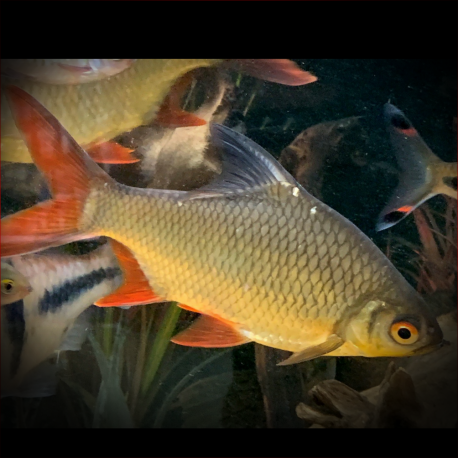More info
Datasheet
| Minimum Tank Size | 500 litres / 132.09 US gallons |
| Maximum Size | 21.0cm / 8.27inches |
| Temperature | 20°C / 68.00°F - 27°C / 80.60°F |
| Hardness | 2.02dgH / 36ppm - 15.02dgH / 268ppm |
| pH | 6.0-8.0 |
Behaviour
The Red-Tailed Tinfoil Barb is not inherently aggressive but may prey on small fishes and disrupt slower or more timid tankmates due to its vigorous feeding behavior and constant activity. To ensure harmonious tank dynamics, it is best housed in very large tanks with robust, similarly-sized companions like cichlids, catfish, other cyprinids, and characins. In nature, this species swims in large schools, and in captivity, maintaining a group of six or more individuals is recommended to prevent skittish or aggressive behavior. Keeping them in adequate numbers not only enhances the aesthetic appeal of the aquarium but also stimulates intriguing interactions among the fish.
Feeding and Diet
Known to be omnivorous and opportunistic, the Red-Tailed Tinfoil Barb primarily leans towards herbivory, although it will consume invertebrates, algae, smaller fish, aquatic and terrestrial plant matter, and even carcasses of deceased animals in the wild. In captivity, they readily accept various foods like chironomid larvae, Daphnia, Artemia, along with quality dried flakes, granules, and vegetable matter. Offering a varied diet comprising live and frozen foods, along with vegetables like shelled peas, blanched courgette, and fruits, is beneficial. It's important not to overfeed, especially with larger items like earthworms or mussels.
Reproduction & Dimorphism
While the Red-Tailed Tinfoil Barb has not been successfully bred in private aquariums, it is utilized in aquaculture projects in its native regions. Like its genus members, this species is an egg-scatterer with no parental care, capable of releasing thousands of eggs in a single spawning event. Sexual dimorphism is minimal, with mature females showing a deeper body profile, particularly during spawning, as the main distinguishing feature.
Habitat and Distribution
In the wild, the Red-Tailed Tinfoil Barb predominantly inhabits large river channels prone to flooding during the wet season, as well as adjacent floodplains. During the rainy months, these fish venture into flooded agricultural areas and forests to feed and spawn, returning to the main rivers as the water recedes. They can also be found in significant numbers near human settlements and towns. Its distribution ranges across Thailand, Laos, Cambodia, and Vietnam, encompassing major river systems like the Mekong, Chao Phraya, and Mae Klong rivers, with the type locality simply noted as "Thailand".
Aquarium Setup
For optimal care of the Red-Tailed Tinfoil Barb, a tank size of at least 500 liters is recommended. Water quality is paramount, and while décor is not a critical factor, providing ample open swimming space is essential. Robust filtration systems, such as external filters, are necessary to maintain oxygen levels, water flow, and bacterial colonization. Due to their skittish nature, a secure, tight-fitting tank cover is advised to prevent potential jumping incidents.
See table for specific water condition parameters.

